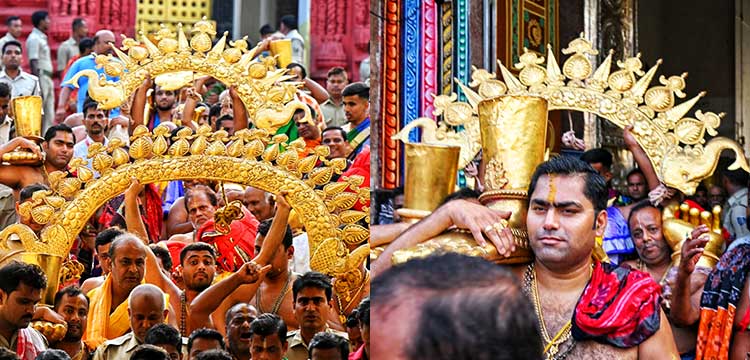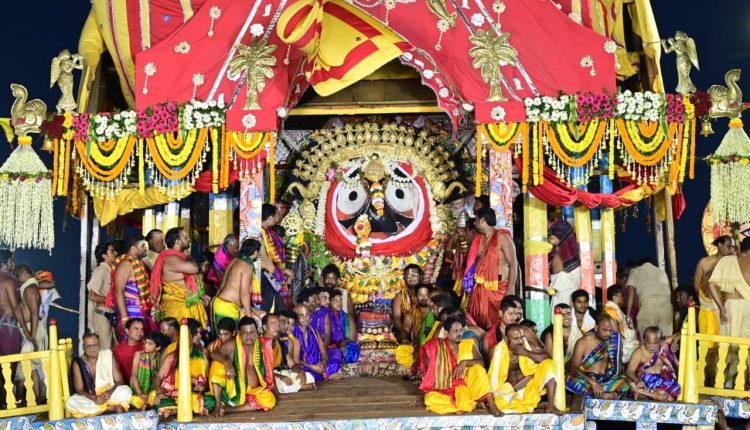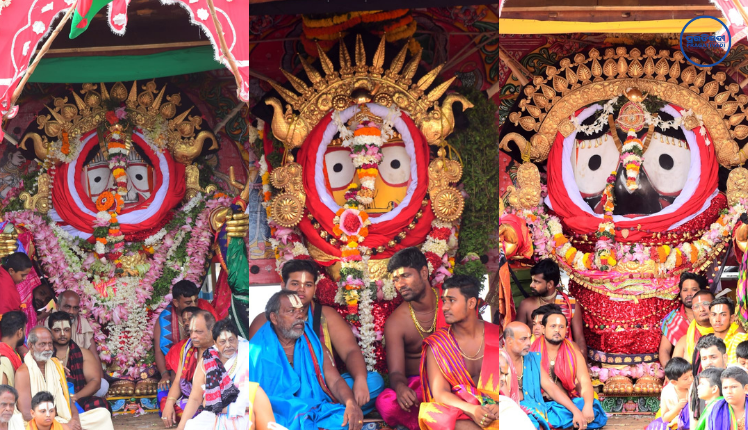The Suna Besha, also known as the Rajarajeswari Besha, is the most desired and adored decoration of the idols at the Lord Jagannath Temple, attracting millions of worshipers each year.
The Suna Besha, observed on the auspicious Asadha Sukla Ekadasi Tithi, is accompanied by a compelling narrative that serves as the foundation for its great celebration. The air is filled with pleasure and festivity as lakhs of devotees flock to see the towering idols, dressed in gold. This sacred occasion exemplifies the Suna Besha’s enduring commitment and veneration, making it a genuinely memorable experience for all who witness its magnificence.
As the goddesses prepare to give darshan to their numerous devotees; Know about the fascinating history and lesser-known facts surrounding this resplendent celebration.

History
According to the Madala Panji, Gajapati Kapilendra Deba defeated the Deccan lords in 1460 with the divine graces of Lord Jagannath and Maa Jayadurga. He returned with a massive treasure, loading 16 elephants with gold and other valuables. In an incredible act of devotion, he offered the entire treasure to Lord Jagannath. Kapilendra Deba then expressed a wish to use the gold to make elaborate decorations for the deities. He communicated his vision with Tadhau Karana, the gold custodian, who was tasked with making it a reality.
However, Tadhau Karana made a humble plea of Gajapati Kapilendra Deba. He saw that many followers were unable to see the holy Beshas (ornaments) within the temple. Therefore, he suggested that the Suna Besha (Golden Ornamentation) be displayed on the chariots during Bada Ekadashi, allowing devotees of all faiths to behold the resplendent deities. Kapilendra Deba graciously approved this proposal, and thus, the annual Suna Besha celebration starts.
During this grand occasion, the deities are dressed with about 208 kg of gold, creating a breathtaking spectacle. According to legend, during Kapilendra Deba’s reign, the deities were decorated with an astounding 138 designs of gold jewelry. Although the number of patterns has diminished with time, the deities remain beautifully decorated with 20 to 30 different types of gold jewels, demonstrating Kapilendra Deba’s enduring love.

The gold ornaments are kept in the outer chamber of the Ratna Bhandar. Armed police officers and temple officials accompany bhandara mekap priests as they deliver the jewelry to Puspalaka and Daitapati priests. This is a list of the ornaments used in the besha.
- Suna Hasta – Golden Hand
- Suna Payar – Golden Feet
- Suna Mukuta – Golden Crown
- Suna Mayur Chandrika – A Golden Peacock Feather Used By Shri Jagannath
- Suna Chulapati – A Golden Ornament Worn Traditionally On The Forehead
- Suna Kundal – Golden Earring Of Hanging Round Ball Type
- Suna Rahurekha – A Half-Square-Shaped Golden Aura Around The Deities
- Suna Mala – Necklaces With Several Designs Made Of Gold. These include:
- Padma Mala –Necklace Of Lotus Flower
- Sevati Mala – Necklace Of Chrysanthemum Flower
- Agasti Mala – Necklace Of Moon Shaped Flower Design
- Kadamba Mala – Necklace Of Kadamba Flower
- Kante Mala –Necklace Big Gold Beads
- Mayur Mala – Necklace Shaped As Peacock Feathers
- Champa Mala –Necklace Of Champak Flower
- Suna Chakra – Golden Wheel
- Suna Gada – Golden Bludgeon
- Suna Padma – Golden Lotus
- Rupa Sankha – A Silver Conch







 Finance
Finance







